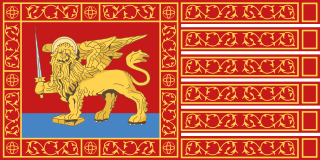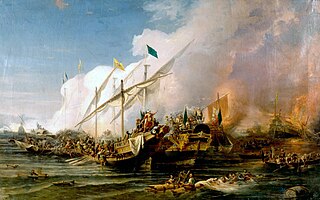Background
During the fourteenth, fifteenth, and sixteenth centuries, Italian states cultivated commercial, diplomatic, and political relations with first the Turkoman emirates of western Anatolia, and then the Ottomans (as well as other eastern Mediterranean states) as part of their multifaceted to maintain long-established trading empires and to keep the Ottoman armies out of the Italian peninsula.
- — Daniel Goffman, "Negotiating with the Renaissance State: The Ottoman Empire and the New Diplomacy" [1]
Out of all the Italian states, the Venetians and the state of Venice faced these threats the most directly because the Ottoman armies and navies began to push up and into the Adriatic Sea. The military threat of the Ottoman Empire loomed large within Italian consciousness, but the government of the Republic of Venice knew that its commerce depended less and less on its own natives and armies and more and more on its good relations with the Ottoman Empire. As a result, this forced Venice to feel the need to an Ottoman world in the making because the Ottoman Empire had been expanding so rapidly at the time.
There were very many Venetian merchants that lived within the Ottoman Empire which made the state of Venice feel a need to protect their merchants in the "foreign" and "fearful" places under Ottoman rule. The Venetians sought to do so by appointing permanent representatives known as consuls, better known as ambassadors, whose job was to shield their subjects in the "foreign" state and describe in frequent letters the happenings within the Ottoman state. This system is thought to have been the beginning of the development of modern diplomacy in Europe. Upon their return to the Venetian state, these permanent representatives would present the happenings that they witnessed within the Ottoman Empire to the Republic in a document known as relazione. Beginning in 1454, an appointed permanent representative always resided in the Ottoman State (usually in the Ottoman capital).

The Republic of Venice or Venetian Republic, traditionally known as La Serenissima, was a sovereign state and maritime republic in parts of the present-day Italian Republic that existed for 1,100 years from 697 until 1797. Centered on the lagoon communities of the prosperous city of Venice, it incorporated numerous overseas possessions in modern Croatia, Slovenia, Montenegro, Greece, Albania and Cyprus. The republic grew into a trading power during the Middle Ages and strengthened this position during the Renaissance. Most citizens spoke the Venetian language, although publishing in Italian became the norm during the Renaissance.
The Treaty of Hünkâr İskelesi was a treaty signed between the Russian Empire and the Ottoman Empire on July 8, 1833, following the military aid of Russia against Mehmed Ali that same year. The treaty brought about an alliance between the two powers, as well as a guarantee that the Ottomans would close the Dardanelles to any foreign warships if the Russians requested such action. The treaty would have significant consequences regarding the Ottoman Empire's foreign relations, especially with Great Britain and Ireland, as the terms of the treaty worried the other great powers of Europe.

The Uskoks were irregular soldiers in Habsburg Croatia that inhabited areas on the eastern Adriatic coast and surrounding territories during the Ottoman wars in Europe. Bands of Uskoks fought a guerrilla war against the Ottomans, and they formed small units and rowed swift boats. Since the uskoks were checked on land and were rarely paid their annual subsidy, they resorted to acts of piracy.

A bailo, also spelled baylo was a diplomat who oversaw the affairs of the Republic of Venice in Constantinople, the capital of the Ottoman Empire, and was a permanent fixture in the city around 1454.

The Köprülü era was a period in which the Ottoman Empire's politics were frequently dominated by a series of grand viziers from the Köprülü family. The Köprülü era is sometimes more narrowly defined as the period from 1656 to 1683, as it was during those years that members of the family held the office of grand vizier uninterruptedly, while for the remainder of the period they occupied it only sporadically.

The Seventh Ottoman–Venetian War was fought between the Republic of Venice and the Ottoman Empire between 1714 and 1718. It was the last conflict between the two powers, and ended with an Ottoman victory and the loss of Venice's major possession in the Greek peninsula, the Peloponnese (Morea). Venice was saved from a greater defeat by the intervention of Austria in 1716. The Austrian victories led to the signing of the Treaty of Passarowitz in 1718, which ended the war.

An Ahdname, achtiname or ahidnâme is a type of Ottoman charter commonly referred to as a capitulation. During the early modern period, the Ottoman Empire called it an Ahidname-i-Humayun or an imperial pledge and the Ahdname functioned as an official agreement between the Empire and various European states.
Esnaf is a Turkish word which means "corporation". During the Early Modern Period belonging to a guild gave people a voice and was an important part of one's identity. Handicraft producers were linked to one another by a range of social, political, and economic ties. Guilds varied among societies, social class, and genders. There were many misconceptions, differences, as well as similarities between Europe and the Ottoman Empire. There were hierarchies within guilds; sometimes they shared tools, worked together, or worked alone.

The Fourth Ottoman–Venetian War, also known as the War of Cyprus was fought between 1570 and 1573. It was waged between the Ottoman Empire and the Republic of Venice, the latter joined by the Holy League, a coalition of Christian states formed under the auspices of the Pope, which included Spain, the Republic of Genoa, the Duchy of Savoy, the Knights Hospitaller, the Grand Duchy of Tuscany, and other Italian states.

The Third Ottoman Venetian War (1537–1540) was one of the Ottoman–Venetian wars which took place during the 16th century. The war arose out of the Franco-Ottoman alliance between Francis I of France and Süleyman I of the Ottoman Empire against the Holy Roman Emperor Charles V. The initial plan between the two had been to jointly invade Italy, Francis through Lombardy in the North and Süleyman through Apulia to the South. However, the proposed invasion failed to take place.

Diplomacy comprises spoken or written communication by representatives of state, intergovernmental, or nongovernmental institutions intended to influence events in the international system.
The European consuls in the Ottoman Empire began as informal relationships between merchants residing in the Empire and the Sultan. The relationships were defined by the ahdname granted by the Sultan which would stipulate the religious freedom and exemption from the taxes that non-Muslim subjects had to pay. The religious implications of these relationships diminished over time as the commercial aspects took over.
In countries outside of its borders, a foreign power often has extraterritorial rights over its official representation. If such concessions are obtained, they are often justified as protection of the foreign religion such as the ahdname or capitulations granted by the Ottoman Sultan to commercial Diasporas residing in the Ottoman Empire. The Sultan did not see this agreement as a bilateral agreement between equals, but merely as acknowledging the nation of foreigners living within his territory and offering them privileges similar to those given to non-Ottoman subjects. However, the European states viewed the ahdname as formal and official and therefore had difficulty enforcing the privileges to their satisfaction on many occasions.
The Venetian army was the army of the city-state of Venice, and later of the Republic of Venice and its dominions. During the Republic's early centuries, it was a force comprising an urban militia.

The Venetian navy was the navy of the Venetian Republic which played an important role in the history of the republic and the Mediterranean world. It was the premier navy in the Mediterranean Sea for many centuries between the medieval and early modern periods, providing Venice with control and influence over trade and politics far in excess of the republic's size and population. It was one of the first navies to mount gunpowder weapons aboard ships, and through an organised system of naval dockyards, armouries and chandlers was able to continually keep ships at sea and rapidly replace losses. The Venetian Arsenal was one of the greatest concentrations of industrial capacity prior to the Industrial Revolution and responsible for the bulk of the republic's naval power.

The Ottoman decline thesis or Ottoman decline paradigm is an obsolete historical narrative which once played a dominant role in the study of the history of the Ottoman Empire. According to the decline thesis, following a golden age associated with the reign of Sultan Suleiman the Magnificent, the empire gradually entered into a period of all-encompassing stagnation and decline from which it was never able to recover, lasting until the dissolution of the Ottoman Empire in 1923. This thesis was used throughout most of the twentieth century as the basis of both Western and Republican Turkish understanding of Ottoman history. However, by 1978, historians had begun to reexamine the fundamental assumptions of the decline thesis.

The Transformation of the Ottoman Empire, also known as the Era of Transformation, constitutes a period in the history of the Ottoman Empire from c. 1550 to c. 1700, spanning roughly from the end of the reign of Suleiman the Magnificent to the Treaty of Karlowitz at the conclusion of the War of the Holy League. This period was characterized by numerous dramatic political, social, and economic changes, which resulted in the empire shifting from an expansionist, patrimonial state into a bureaucratic empire based on an ideology of upholding justice and acting as the protector of Sunni Islam. These changes were in large part prompted by a series of political and economic crises in the late 16th and early 17th centuries, resulting from inflation, warfare, and political factionalism. Yet despite these crises the empire remained strong both politically and economically, and continued to adapt to the challenges of a changing world. The 17th century was once characterized as a period of decline for the Ottomans, but since the 1980s historians of the Ottoman Empire have increasingly rejected that characterization, identifying it instead as a period of crisis, adaptation, and transformation.

Giacomo Cantelli da Vignola was an Italian cartographer and engraver of the 17th century.
Virginia H. Aksan is a Canadian historian. She is an honorary member of the Turkish Historical Society who research interest Ottoman Empire. Aksan completed her bachelor's degree at Allegheny College in the United States when she was learning Turkish language at Princeton University.












